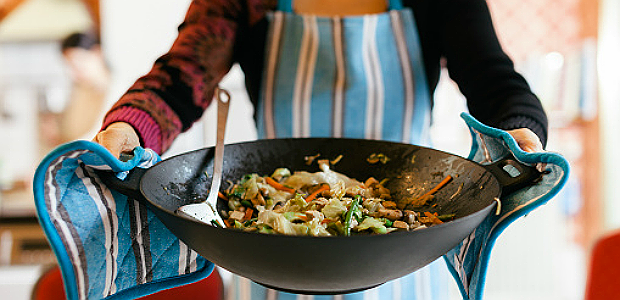There are loads of reasons to love a stir fry:
1. It’s easy and quick to cook.
2. You can mix and match ingredients to suit your mood or budget.
3. It makes for great leftovers for lunch the next day.
4. It’s a great one-pan wonder that doesn’t require you to wash a million pots and pans.
Here’s how to master them.
The first thing to note is that the method of cooking a stir-fry is very quick, making it the perfect midweek dinner – but it also means you have to have everything ready and waiting in the wings before you start.
Mise en place
This is fancy French cooking speak directly translated as ‘putting in place’ i.e. have everything together – both in terms of ingredients and their preparation. Make sure your veggies and meat are chopped, your oil is out, seasoning is on hand and all the utensils you’ll need throughout the process are laid out.
Use small bowls to hold each prepped ingredient and make space on your countertop for them all to fit. When chopping vegetables and meat, always do so with the aim of getting greater surface area, resulting in more contact with the heat and also more flavour.
Oils
A stir fry requires high heat, so you’ll need to cook with oils that can withstand that and have a high smoke point. The best are vegetable oil (smoke point of 205°C to 230°C ), peanut oil (smoke point of 230°C ) avocado oil (smoke point of 271°C) or grapeseed oil (smoke point of 215°C). Sesame oil is great to add at the end of cooking for an Asian-style flavour.
Heat really is your friend here – it cooks the food really quickly and gives it the desired stir fry texture. Make sure that the wok or pan is literally smoking hot before adding your ingredients. (Woks provide a large surface area and retain heat very well. If you don’t have a wok, we suggest using a cast iron pan.)
The order of cooking
Determine which ingredients need the most cooking time and add these first. Usually, this is meat or more robust vegetables that take a bit of time to become tender.
Meat
(if using)If you’re using meat, always cut with the grain lengthways to get the best out of its texture. Marinate your meat for at least an hour beforehand to add depth and flavour to it. Some good-quality soy sauce, grated fresh ginger and garlic, and a bit of lemon or lime juice make for a quick and easy basic marinade.
When it’s time to cook the meat, make sure that it has come to room temperature before adding it to the hot wok or pan. Also make sure that you don’t boil the meat – you want to sear it and give it a nice texture and colour.
If you’re going meat-free, you might want to substitute the meat for something like tofu or tempeh.
Vegetables
Start from least tender to most tender (broccoli and carrots, for instance, should be cooked ahead of mushrooms). You want to make sure that it’s cooked evenly, so it’s best to move everything around continuously so that every inch reaches contact with the heat. Choose vegetables that don’t go mushy easily and can withstand high heat.
Sauce
A stir fry sauce isn’t essential, but it can add an extra lift to the dish. Use a store-bought one if you’re lazy (no judgies!), or make your own with whichever saucy Asian-style liquids you have on hand – just be sure it’s balanced in flavour and intensity. If you want a thick sauce, simply stir a cornstarch slurry into the sauce before adding it to the food.
Garnishes and additions
A nice way to bulk up your stir fry is by serving it with a neutral starch like noodles or rice. This brings the whole dish together nicely and makes it go further, too. Top with something fresh and vibrant like a bunch of chopped fresh herbs – coriander, crunchy sprouts, toasted sesame seeds and coconut flakes all work really well.
Hungry? Try these recipes!
Beef, cashew and broccoli noodle stir-fry

